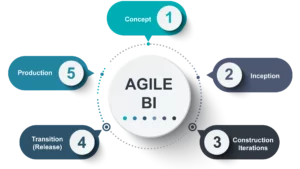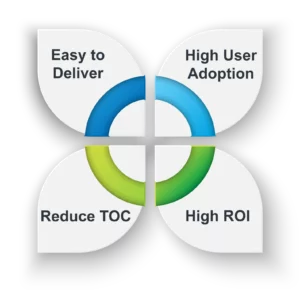Agile business intelligence is a method of implementing business intelligence (BI) tools and initiatives by using the agile methodology commonly adopted in software development.
While adopting agile business intelligence processes, the business intelligence team is often comprised of software developers who understand the agile methodology. Just like any other agile implementation, BI projects are split into a set of small projects that undergo the following on a continuous basis:
- Planning
- Development
- Testing &
- Deployment
Having such a segmented yet iterative approach ensures continuous improvement in the overall project and measurable progress. Organizations can quickly roll out their products to the market, due to agile methodology.
Similar to other business intelligence initiatives, the agile business intelligence model is deployed with an intent to reduce the total cost of operations (TOC). It also enables a significant change in the digital transformation of the organization as it brings about great flexibility and a change in the organizational culture, through the adoption of technology.
What is Agile Business Intelligence?
Agile Business Intelligence is nothing but the utilization of agile software methodology specifically for Business Intelligence projects. Software developers prefer this method as it reduces go-to-market time and helps them to cater to the dynamically changing user demands.
It is a recurrent process, where the product undergoes continuous evolution with constant iterations in the user interface, visualizations, reports, dashboards, and new BI features and functionalities that are added over a period of time, depending on market demands.
Agile business intelligence is quite regularly used in embedded business intelligence projects, which requires additional layers of embedded software integration, mainly to meet the requirements of end-users.
A very fundamental requirement of agile methodology and business intelligence is the team’s detailed knowledge of the business intelligence capabilities of their product. If deployed correctly, agile business intelligence platforms can help in users’ adoption for a longer duration of time.
Importance of Agile Business Intelligence
As it is quite evident that Business Intelligence combined with agile development methodology is proven to be a successful approach, vis-à-vis the traditional approach.
Agile Business Intelligence helps in selecting the right set of BI software for specific projects. Most of the modern BI tools are built on the agile methodology making them far more superior compared to tools coming out of the traditional approach.
Another significance of agile business intelligence methodology is that it ensures1 that the users are involved continuously. Both business users and product owners are constantly engaged in the deployment monitoring the progress at each step.
Having an agile BI method helps product owners to address numerous change requests in a simplified manner. Each change is addressed as individual projects and deployed after going through the process before it is made available to users.
By implementing BI solutions using agile methodology, IT teams can deliver good quality solutions and products to the organization.
(Also Read: Agile Marketing: A Step-By-Step Guide)
Agile Business Intelligence Methodology
Implementing the agile business intelligence method is a very simple process. It involves running small iterative projects. The following diagram indicates a 5 step iterative method of agile BI methodology.
If we look at a traditional methodology, the interaction between business users and developers was not considered to be a part of the process. However, today the role of developers is far from technology and data. They have to answer pertinent questions and ensure that the solution built is in line with the requirement.
By implementing agile business intelligence platforms, organizations can see a relatively faster return on investment.
Let us look at each of the 5 steps in this methodology
-
Concept
A stage where teams start to put together a broad-level vision of the BI initiative. The concept is just defining a top-level map of the project without much detailing. Usually, this is achieved through a whiteboard session or maybe on a piece of paper.
-
Inception
Here, developers achieve a major milestone by implementing the active participation of stakeholders. Within the inception stage, it also covers:
- Train the stakeholders on the basics of agile
- Identify the funding of the BI initiative and set up the support
- Find out potential sources of data
- Prioritize business requirements and also identify the needs, keeping in mind the challenges around budget and timeline
-
Construction Iterations
In this stage, the developer delivers a working prototype that is meeting the growing requirements of stakeholders. This will be a cyclical method and repetition of this stage and the next one but in a series of increments.
-
Transition
This is the phase where the product that has gone through the previous stage of construction iterations, is being prepared for production movement. Stage 3 and 4 happen in increments and finally, after completion of these two stages, the product reaches the final stage (production). During the transition phase, a developer:
- Keeps the stakeholders updated
- Finalize testing scenarios
- Finalize all necessary documentation
- Release of the pilot to a small group
- End-user training
- Train the production team
- Final deployment into production
-
Production
This is the final stage, where users start operating the system that has come out of construction iterations and transition stages. During this stage:
- Users will operate the system, dashboard, and reports
- Identify defects in the system and potential areas of improvement.
These changes will begin and construction iterations stage and move forward.
This is a critical stage as users need to keep an eye on the operability of the system and overall system utilization.
Benefits of Agile BI
While deploying a business intelligence project, agile methodology is very pertinent. This is primarily because agile methodology covers a multitude of business processes, that encompass constant changes and can implement these feedbacks and changes through a continuous process.
Having agile methodology allows developers to deploy small chunks of software projects in an iterative manner. A major benefit of going this way is that it brings about tremendous flexibility in delivery, easier user adoption, and faster return on investment.
In most agile business intelligence projects, the stakeholder team does have clear visibility on the objective of this initiative. These objectives are usually not documented at the beginning, hence, a waterfall or iterative approach, followed in agile methodology, helps in breaking the entire project into components such as dashboards and reports.
To summarize, these benefits can be put into four buckets
What challenges does Agile BI solve?
One of the primary challenges that agile business intelligence methodology solves is the time-to-market, particularly where the ROI achievement timeline is longer, and the initial investment is very high. However, due to constant change in the requirements of OEM customers and the development of SaaS-based solutions, has created a burgeoning rise in the pressure to implement a new Bi platform either internally or within their existing product.
We can see that even today some organizations prefer to go for a perpetual pricing model due to an anticipated long-term gain, while some prefer a subscription-based model that spans the cost over few years.
Does that mean that agile business intelligence does not have a say in today’s Bi initiatives? No, in fact, whenever there is an assessment on optimizing total operational cost (which is crucial for an organization), Agile Business Intelligence methodology becomes even more significant as it reduces the overall total cost of the project.
This helps in bringing about constant improvement thereby resulting in faster market penetration and growth in the overall business.
Agile business intelligence platforms
Having the right business intelligence platform is very critical to the successful implementation of these initiatives. By implementing modern BI platforms and tools, enterprises can address any business challenges that they face. These tools help in analyzing, predicting, and monitoring scenarios for better business decision-making. There are many such platforms available in the market, and we shall have a look at the top 3 to give you an insight on the same.
1. Datapine
Comes with various analytical features, including predictive analytics, where the tool fetches data from multiple sources and runs analytics to derive meaningful information for decision making. It allows users to create fluid dashboards for better representations. Comes with a very intuitive drag and drop UI for seamless operation.
2. SAS Business Intelligence
It is a combination of multiple products that helps data scientists, engineers, analysts, and others. It is one of the oldest in this segment and has been constantly expanding and innovating its product line. One of the key features of SAS is the capability to run analytics on texts.
3. Clear Analytics
This is a tool that collects data from internal business systems like account applications, CRM systems and so on, and push that data into a spreadsheet or Excel format. Works seamlessly with Microsoft Power BI to create various data models. Its integration with Power BI and Microsoft Excel happens to be one of the USPs making it a preferred BI tool.
Over and above these three, there are other platforms such as Business Objects by SAP, DOMO, Metric Insights, Zoho Analytics, and so on.
Tips for Agile Business Intelligence
To ensure a successful implementation of the agile business intelligence platform, here are some additional tips that will help you in achieving the same.
- Ensure that the stakeholders are constantly updated about every step in this initiative. It is also important to have these stakeholders actively participate in this process and be continuously engaged with it.
- Document all the key action items only wherever necessary. A key difference between traditional methodology and agile is that agile is more about daily scrum meetings for enhanced team communication. Hence, it does not require too much documentation – but only wherever pertinent.
- In case there is a change in the requirement, it is important to accept this change and quickly adapt to it so that there is a better advantage in the market.
- While the product is getting implemented, it is important to test the system continued till the end of its lifecycle.
- If you select a BI software that requires a traditional approach, then all your efforts of having an agile business intelligence platform will go futile. Hence, it is important to select the right BI software.
Final Thoughts
The reporting requirement of enterprises is constantly changing. The only way to address this dynamically change is to have a flexible business intelligence system, that can generate reports as and when required.
A meticulously planned agile implementation of a business intelligence system will ensure that the system caters to the requirement. Having an agile methodology helps the project team to fulfill new requirements from the user group and deliver them quickly.
Organizations can reap the benefits of having an agile business intelligence system to help them make well-informed decisions.








